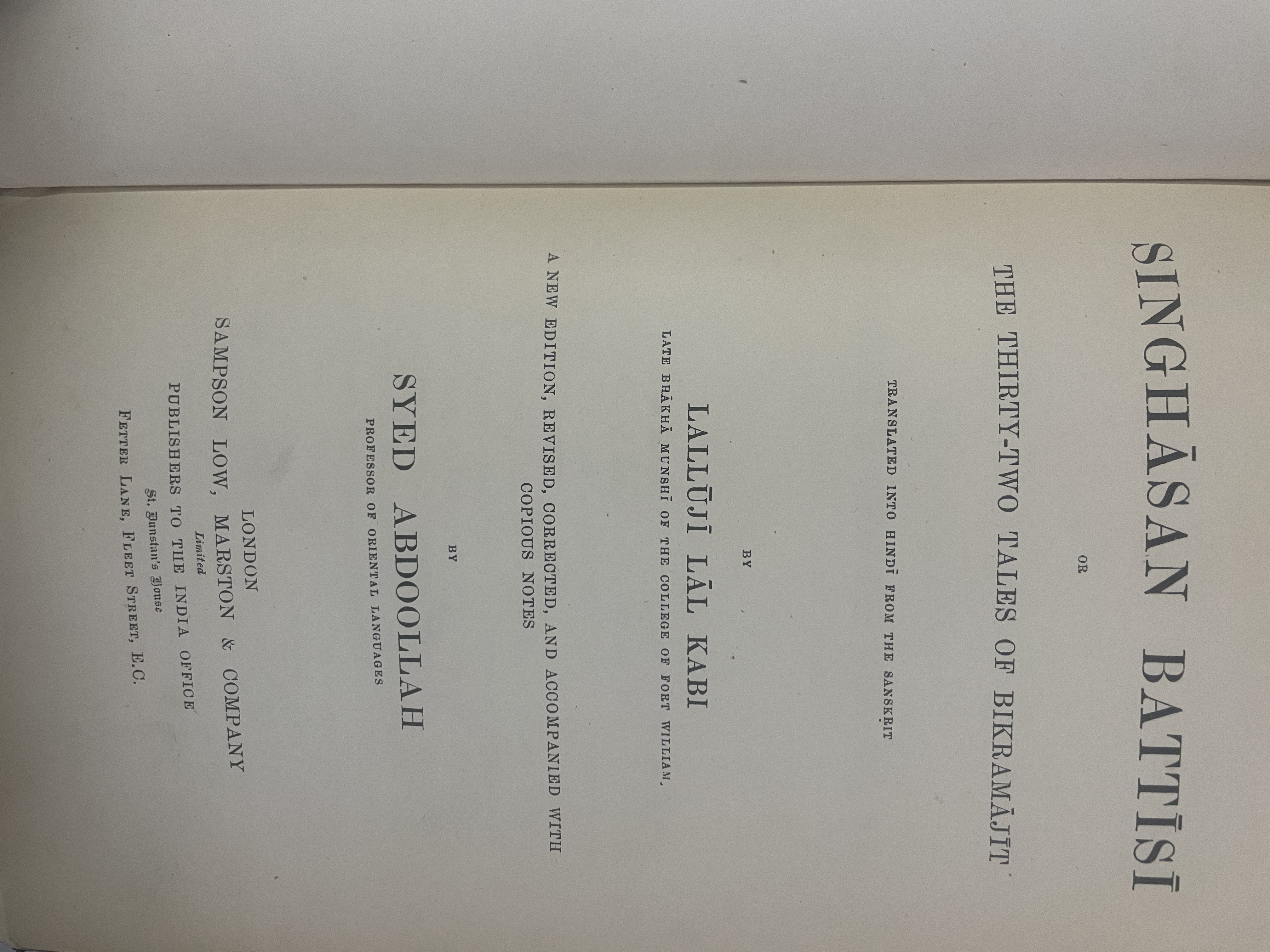Singhasan Battisi or the thirty two tales of bikramajit

About
Summary
Exquisite
TOC
Details
Related
URL
Images
Overview
Singhasan Battisi, also known as thirty-two tales of the throne, is a collection of Indian folk tales centered around King Vikramaditya. The stories are narrated by 32 statues (actually apsaras turned to stone) on King Vikramaditya's throne to King Bhoja, who discovers the throne centuries late.The frame story begins with King Bhoja of Malwa (1010-1055 CE) discovering the throne of the legendary King Vikramaditya. This throne is no ordinary object; it is adorned with 32 figurines, each an apsara (a celestial nymph) petrified by a curse.
When King Bhoja attempts to ascend the throne, the statues come to life, one by one. Each apsara challenges Bhoja's worthiness by narrating a story from the life of King Vikramaditya2. These stories illustrate the virtues and qualities that made Vikramaditya a just and wise ruler, such as selflessness, honesty, impartiality, and a genuine commitment to justice. Through these tales, King Bhoja realizes he does not possess the necessary qualities to rightfully sit on the throne.
Importance of Book
Reflection of Human Emotions: The stories reflect a wide range of human emotions, known as the navarasas, including love, heroism, disgust, anger, mirth, terror, pity, wonder, tranquility, and parental fondling.
Preservation of Ancient Lore: The collection preserves and transmits ancient Indian traditions, values, and cultural beliefs through engaging narratives.
Moral Education: The stories serve as a tool for moral education, teaching children and adults alike about ethical conduct and the importance of virtue.
Entertainment: Singhasan Battisi has been a source of entertainment for centuries, captivating audiences with its magical elements, adventurous plots, and compelling characters.
Key Themes
Justice and Wisdom: The core theme revolves around the qualities of a just and wise ruler, exemplified by King Vikramaditya. The stories emphasize the importance of fairness, righteousness, and the ability to make sound judgments.
Moral Lessons: Each tale imparts a moral lesson, highlighting virtues such as honesty, selflessness, compassion, and the importance of upholding dharma (righteous conduct).
Enlightenment: King Bhoja's journey is one of enlightenment. Through the stories, he gains insight into the life and character of King Vikramaditya, ultimately recognizing his own shortcomings and the qualities needed for true leadership.
Cultural Significance
Preservation of Traditional Values: The stories embody and transmit traditional Indian values, beliefs, and cultural norms. They offer insights into the ethical and moral frameworks that have shaped Indian society for centuries.
Moral Education: The tales serve as a means of moral education, imparting ethical lessons and philosophical insights through engaging narratives. They encourage listeners and readers to reflect on their own actions and strive for moral improvement.
Children's Literature: The stories from Singhasan Battisi hold a unique place in children's literature, remaining popular even today. The simple language and beautiful illustrations are designed to encourage reading habits in children and arouse their interest in ancient literature.
Source of Entertainment: The stories have entertained audiences for generations, providing a source of amusement and escapism. The colorful characters, magical elements, and exciting adventures captivate the imagination and provide a welcome respite from the everyday world.
Reflection of Human Emotions: The stories reflect the nine human emotions (navarasas): love, heroism, disgust, anger, mirth, terror, pity, wonder, tranquility, and parental fondling. This makes the stories relatable and helps children understand the range of human experiences.
Effects on Society
Moral Compass: The stories serve as a moral compass, guiding individuals towards ethical behavior and promoting a sense of social responsibility.
Cultural Identity: Singhasan Battisi contributes to the formation of Indian cultural identity, providing a shared heritage of stories and traditions that bind people together.
Inspiration for Art and Literature: The tales have inspired numerous artistic and literary works, enriching Indian culture and fostering creativity.
Intergenerational Transmission: The stories are often passed down from one generation to the next, ensuring that traditional values and cultural knowledge are preserved and transmitted to future generations.
Contemporary Relevance: The themes and messages of Singhasan Battisi remain relevant today, offering timeless wisdom and insights into the human condition.
Conclusion
Singhasan Battisi is a collection of Indian folktales that offers valuable moral lessons and insights into the qualities of an ideal ruler. Its cultural significance lies in its preservation of traditional values, its role in moral education, and its contribution to Indian cultural identity. The stories continue to entertain, inspire, and guide audiences of all ages, making Singhasan Battisi a timeless treasure of Indian literature.
Title
Singhasan Battisi or the thirty two tales of bikramajit
Author
Syed Abdoollah
Name of Publisher
Sampson Low Marston and Company
Publish Date
1869
Subject
A collection of tales set in the context of a mythical throne that tells stories of various kings and their experiences.
Vintage
1801-1900
Category
India
Sub Category
Social Sciences
Rarity
RARE
